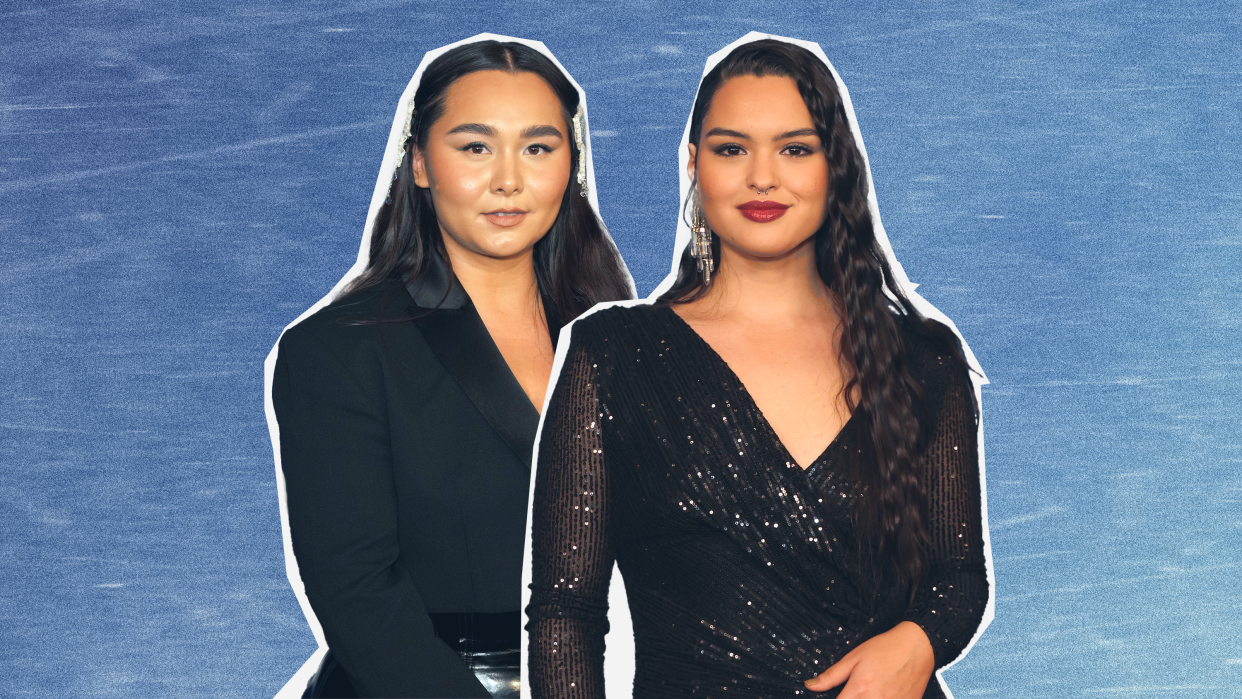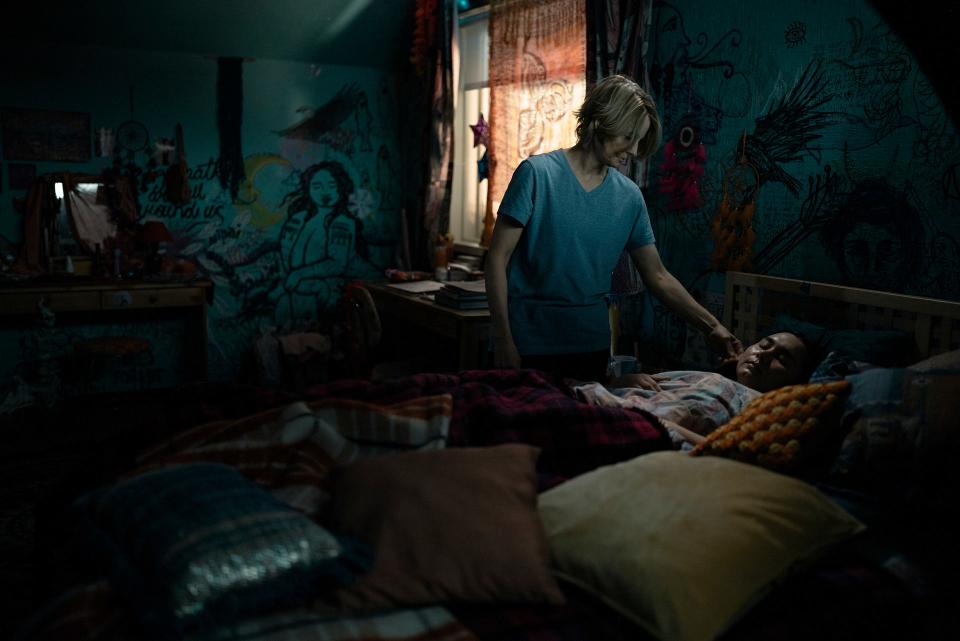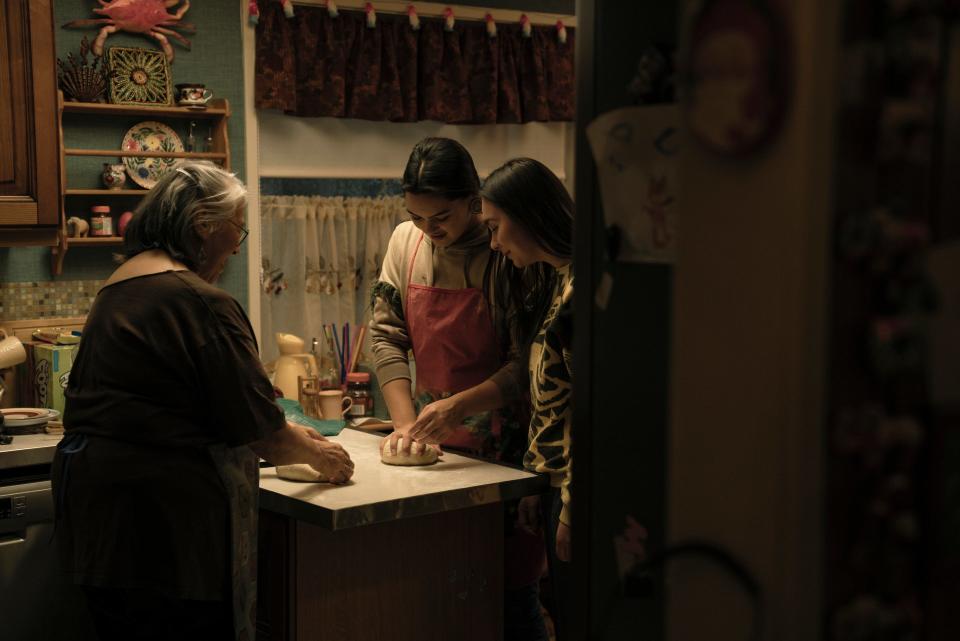Isabella Star LaBlanc and Anna Lambe Are the Heart and Soul of True Detective: Night Country

- Oops!Something went wrong.Please try again later.
- Oops!Something went wrong.Please try again later.
- Oops!Something went wrong.Please try again later.
- Oops!Something went wrong.Please try again later.
The critically acclaimed series True Detective is back. The fourth installment of the thriller returned to HBO on January 14 with Night Country, an atmospheric exploration of life for residents of fictional Ennis, Alaska, after a group of researchers are found stripped naked and frozen in the snow. On its face, the new season is an eerily macabre murder mystery set against the inhospitable landscape of frozen perpetual night. In fact, what director, creator, and writer Issa Lopez built is an intrepid and unapologetic character study about the power, compassion, and kinship of Indigenous women.
On- and offscreen, Indigenous women are the heart and soul of this show. In starring roles, Isabella Star LaBlanc, 26, and Anna Lambe, 23, are acting powerhouses, delivering career-defining performances that are deeply human, gut-wrenching, and historic. LaBlanc, who is Dakota herself, plays Leah, the stepdaughter of Liz Danvers (Jodie Foster); Lambe, who is Inuk, plays Kayla Prior, a young nursing student who’s navigating motherhood and a strained marriage, all while helping Leah explore their characters’ Iñupiaq roots.
In preparation for the show, executive producer Mark Ceryak explains how, along with Lopez, their team met with Illuminative, a social justice organization led by Native women. “They connected us with Princess Daazhraii Johnson and Cathy Tagnak Rexford, who both hail from Alaska and joined us to produce the series,” he said in a statement. Johnson and Rexford assembled an advisory council made up of Iñupiaq women who provided insight and advice on every aspect of production. Together with Lopez, they went through the script page by page, ensuring the story she told was an authentic one.
As a result, Night Country is nothing short of a revelation, taking viewers on a propulsive journey into the depths of the very real scourge of violence and marginalization that Indigenous women face. Critically, it does so by representing Indigenous women not as victims who need saving but as forces to be reckoned with. Each of the six episodes unfolds as a love letter to the noir thriller genre and a testament to the art that can be created when we center the voices of the real people at the heart of the stories we tell.
Watching Lambe and LaBlanc onscreen, it’s apparent that these are two emerging talents, holding their own opposite industry giants like Foster and Fiona Shaw (Rose Aguineau). And offscreen they are every bit as magnetic, carrying an infectious pride in their work and their heritage.
We spoke with Isabella and Anna about the significance of telling Indigenous stories, the singular sense of community on set, and being the presidents of the Jodie Foster Fan Club.
Glamour: This is such an important story about Indigenous women, and it’s significant that Indigenous women like yourselves are front and center in the cast. What did it mean to you both to be on this True Detective set?
Anna Lambe: Being part of this project was really meaningful. I'm an Inuk. I'm from Iqaluit, Nunavut. I grew up there, and I didn't leave until I was 18 to go to university. I’m very proud of where I come from, and very rooted in where I come from. To see the level of care that was put into this production, and to talk with Cathy Tagnak Rexford and Princess Daazhraii Johnson about Alaska, and to connect based on…not our shared realities because it's still very different—but finding those different ways to relate and understand each other was really beautiful. Of course, meeting Izzy and Kali [Reis], it is just such a privilege.
One of the beautiful things about this project and having a show with so many women and so many Indigenous women was the amount of community. The feeling of community and kinship and support was really beautiful and something that can feel so rare on a show as big as this one. It's such an incredible experience, and I'm very proud as a Northerner to be part of telling a Northern story.
Isabella Star LaBlanc: I'm going to second what you said about community and kinship. I'm Dakota, and our name, what we call ourselves, translates to “the friendly people.” What I was always taught growing up is that the way to be a good Dakota person is to be a good relative and to take care of the people around you.
I think that's so often something we leave out of these conversations about representation and about what stories we tell, and that it's really not about what we're doing, what story we're telling. It's about how we do it. I was so grateful that on this production there was so much reciprocity; just as much as I was giving to the team, they were giving back to me and all of these people that I was working with. I think that that does shine in the product.
What was your first impression when you read the script? What was it about the storytelling and Indigenous representation that made you decide to do this project?
Isaballe: What really makes a story scary is when you care about the people. I do think that that is what really drew me into these scripts immediately, and I think what's so often missed in Indigenous stories that are told from non-Indigenous people is that there's so much conversation about what we've lost and there's not really a lot of conversation about what's still at stake.

I thought that Issa did such a beautiful job in this script of making it clear what is at stake for these communities, and what's beautiful and needs to be protected and is under attack, and so I think that is what makes it so terrifying. It felt really amazing to get to see so much of the beauty that I have grown up with in my community represented, even though we're talking about a different community. It felt really special.
Anna: Seeing Indigenous women depicted as strong, but still with moments of vulnerability—I recognize those moments. It’s like the scene with Evangeline [Reis] and her sister, or the scenes showing the midwifery. I was watching it again today and just crying because it's so beautiful that we get to experience this onscreen. You could feel that there's so much love that went into it.
The scripts were a representation of Indigenous women that I hadn't really seen much of before in film and television. I feel like, for a lot of us, there was this automatic sense of responsibility in the storytelling. I think it translated so beautifully. What a privilege to be part of it.
I have to ask, what was it like working with Jodie Foster?
Isabella: I mean, Jodie is incredible, and I feel so grateful that so much of my journey on the show is opposite her. I felt like I just got this invaluable opportunity to soak in all her brilliance. There's no one that doesn't like her, and she's really owned her career. She's really had the reins, and I'm so inspired by that. I look back at what she did leading up to The Silence of the Lambs, what she did after, and how every step of the way you can tell she's been really intentional about doing things that matter to her, taking care of herself as a person, taking care of herself as an artist. I feel like now I'm the president of her fan club. I'm sure there's a lot of people who would fight me for that title, but I will fight.

Anna: Working with Jodie is literally a master class, not only in acting, but also in how to carry yourself through a set and through an industry so gracefully. I think she's been such an incredible inspiration for young actors, and somebody who really guides and protects them, especially young queer actors. [It's inspiring] seeing her being outspoken and supportive of actors like Bella Ramsey. When I grow up, I want to be like Jodie Foster.
Without giving too much away, I think at its heart this show was not only about the pain and suffering of Indigenous women, but more importantly, about their resilience, their fight.
Isabella: I'm obsessed with [how Issa told that story]. It feels so satisfying because I think to me, growing up and even now, I know that in my community we've had to be our own heroes for generations, but that's not the story that ever gets told. It's always that someone else has to come in and save us, and so it felt incredible to get to see this feels like the truth to me. You're right that it's both, that we can be both.
Anna: I really love that it was about the women, and it was about justice. How do we define justice? What does justice mean to us in our communities? It wasn't about romanticizing the struggles of Indigenous peoples and especially the struggles of Indigenous women. It wasn't about sensationalizing a case and the focus being on, “Oh, what is the case? What happened?”
As much as that is a very important element of the show, there's this constant push to understand why this violence is being inflicted upon Indigenous women, why the community of Ennis is experiencing what it's experiencing. It is so, so powerful because often in the media, it's just the death that gets all the attention and not who they were and what they had to give to their community and their place.
There are plenty of twists that are going to throw viewers for a real loop, but without giving too much away, what do you think will surprise them the most?
Isabella: I mean, Liz Danvers is wild, and the things she says are wild. There were sometimes that we would be shooting scenes, and I would have to stop myself from laughing because I'm like, “It is so wonderful to watch Jodie Foster being this sometimes terrible person. It's very delicious to see.”

I hope some people are clutching their pearls at Alaska Karen. There's the one scene where I'm at Kayla's house, and the grandma's doing the lines on me, and Danvers comes in, and she was like, I don't know, something along the lines of, “Shut up, laundromat grandma.” I remember when we shot that, and I was like, “Does she really say that? That is so wild.”
Originally Appeared on Glamour

